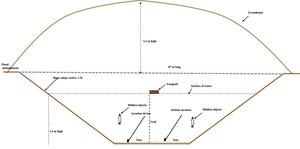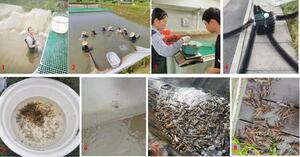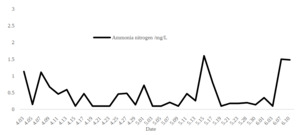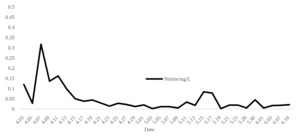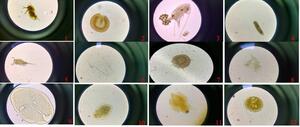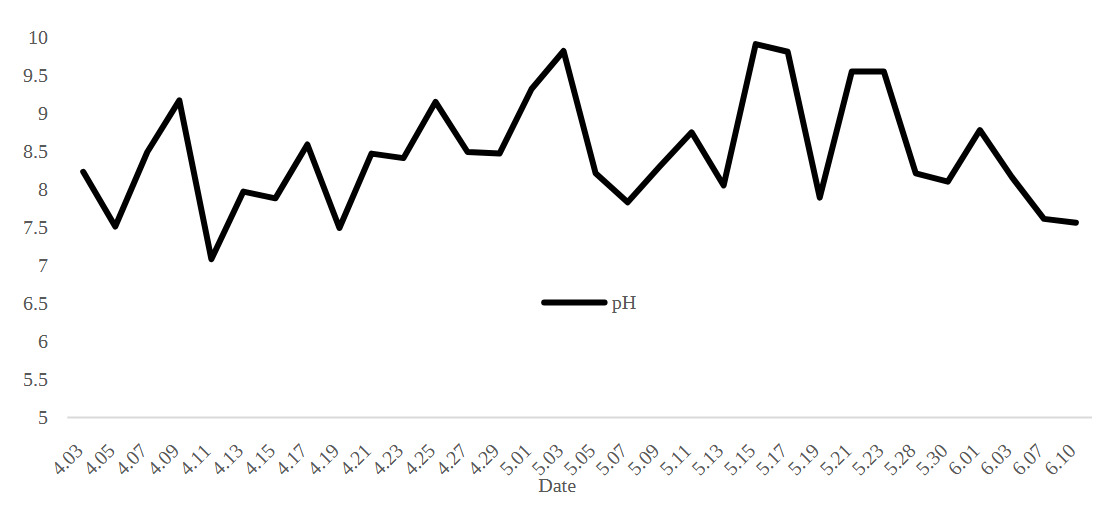1. Introduction
Redclaw crayfish (Cherax quadricarinatus), an economically important freshwater crayfish, has considerable market potential, and its aquacultural development in China has recently been growing rapidly.1,2
After hatching, the shrimp become juveniles, which are small, have weak adaptability to the external environment, and cannot resist or avoid enemies. Generally, these juveniles must be cultivated in cement pool greenhouses and pond greenhouses until they reach a certain size before being placed in outer ponds for aquaculture. However, during the cultivation process, a significant number of juveniles are lost due to their aggressive behavior and tendency toward cannibalism, particularly during the vulnerable molting stage. Besides, a major challenge restricting the industrial development of redclaw crayfish is the insufficient supply of seedlings, especially large seedlings. Farmers prefer breeding large seedlings as they have lower breeding difficulty and more stable production, which improves enthusiasm and promotes breeding. Therefore, large-sized seedlings garner high market demand. One of the key challenges in further increasing the mass supply capacity of large-sized redclaw crayfish seedlings is to improve their survival and growth rates by selecting important parameters such as bait composition, feeding frequency, and juvenile density based on the habits of the seedlings.
An adequate feed supply and excellent nutritional conditions are important factors in promoting juvenile growth.2 Extensive studies have demonstrated that bait composition and feeding frequency significantly affect the survival and growth of juvenile crayfish. Xu et al.3 compared the feeding rates and feeding effects of plant- and animal-based feeds on Procambarus clarkii juveniles. Dan et al.4 studied the relationship between food composition and habitat, as well as changes in the feeding activities of P. clarkii in different habitats. The purpose of the aforementioned studies was to ensure a limited food supply, improve the survival rate of crayfish, and promote their growth. However, there are still some research gaps. First of all, there has been relatively little research on redclaw crayfish juveniles, and secondly, no studies have been conducted on feeding additives for juveniles during temporary cultivation in a cement pool greenhouse. Adequate nutrients guarantee the survival rate of juveniles, and the intake and accumulation of nutrients in feed or feed additives for juvenile crayfish is of great significance.5 Although formulated feed has the advantages of comprehensive nutrition, consistent quality, convenient feeding, and easy storage and transportation, its effectiveness may be mediocre because of insufficient supplementation of important trace elements during specific stages when crayfish require rapid nutrient supplementation. Moreover, additives like Antarctic krill oil and Spirulina powder might help with the growth and survival of juveniles. Because Antarctic krill oil contains phospholipids, EPA, DHA, vitamins, and trace elements that are rich in nutrients and protect the liver. They enhance nutrition, improve immunity, and reduce stress-induced damage.6 Spirulina powder has high protein and low-fat content and is rich in vitamins, minerals, and amino acids. Therefore, in this study, we added Antarctic krill oil and Spirulina powder to compound feed to provide comprehensive nutrition, stable quality, convenient feeding, easy storage and transportation, and to be conducive to epidemic prevention.
In addition, owing to the tropical nature of redclaw crayfish, common problems, such as short breeding cycles, small cultivation specifications, and low seedling survival rates in non-tropical areas, hinder its industrial development. Therefore, it was necessary to breed temporarily reared juveniles in a pond greenhouse to cultivate large-sized redclaw crayfish seedlings. Cheng et al.2,7 explored the establishment of a suitable pond aquaculture model for redclaw crayfish based on its biological characteristics and differences in climate and consumption demands in northern Zhejiang. The model was called the small-shed standard coarse pond aquaculture model, and through demonstration, industrial development and promotion of redclaw crayfish could be achieved. In addition, Cheng et al.8 evaluated the effects of three different redclaw crayfish juvenile cultivation modes, namely cement pool greenhouse, circulating water tank, and net cage in pond greenhouse cultivation modes, and explored the effects of concealment and density on the survival and growth of juveniles under different modes. Their results showed that large-scale juvenile cultivation using net cages in pond greenhouses is advantageous. Breeding and large-sized seedling cultivation have also been applied to species such as P. clarkii, Macrobrachium rosenbergii, and Litopenaeus vannamei.9–11 Although these studies laid the technical foundation for this experiment, however, there are still some research gaps, first of all, there have been no studies on large-sized redclaw seedling cultivation in pond greenhouses, and secondly, owing to the characteristics of cannibalism and weak adaptability of juveniles, it is necessary to apply the two-step relay mode of indoor cement pool greenhouses and outdoor pond greenhouses for cultivating large seedlings, however, so far, there have been no relevant research reports. A hypothesis is that the two-step relay mode can fully utilize the advantages of concentrated feeding, convenient management, easy environmental control of juveniles in indoor cement pools, large and stable water quality, high amounts of plankton, abundant natural feed, and complex hidden environments in outdoor pond greenhouses, effectively improving the survival and growth rates of juveniles. Therefore, this study will apply the two-step relay mode. Besides, density is one of the critical factors during pond greenhouse cultivation. Chen et al.12 found that density not only affected the growth and development of shrimp but also had a significant impact on the survival of shrimp. Zhang13 discovered a correlation between shrimp seedling density and growth rate during greenhouse cultivation.
In conclusion, two experiments were conducted in this study: screening for suitable bait composition and feeding frequency of newly hatched juveniles in a cement pool greenhouse, and screening for densities and analysis of the breeding status of juveniles in a pond greenhouse. Research on important parameters (bait composition, feeding frequency, density) for large-sized redclaw crayfish seedling cultivation aims to achieve better large-sized seedling cultivation.
2. Materials and methods
2.1. Experiment 1: Study of bait composition and feeding frequency of newly hatched juveniles in a cement pool greenhouse
Experimental juveniles were obtained from the Zhejiang Freshwater Fisheries Research Institute, and juveniles with similar specifications were selected (average weight, 0.025 g; average total length, 9.097 mm). The compound feed was purchased from Zhejiang Haida Feed Co., Ltd (China). Feed parameters were as follows: crude protein ≥ 42%, crude fiber ≤ 5%, crude ash ≤ 18%, crude fat ≥ 3%, total phosphorus ≥ 1%, lysine ≥ 2%, moisture ≤ 12%. The raw materials used included fish meal, soybean meal, yeast powder, vitamins, and minerals.
Six experimental groups were set up (raw materials consist of the following weight percentages of components): Group 1: 100% formulated feed (fed once a day), Group 2: 100% formulated feed (twice a day), Group 3: 100% formulated feed (thrice a day), Group 4: 80% feed+10% Spirulina powder+10% Antarctic krill oil (once a day), Group 5: 80% feed+10% Spirulina powder+10% Antarctic krill oil (twice a day), and Group 6: 80% feed+10% Spirulina powder+10% Antarctic krill oil (thrice a day), with three replicates in each experimental group (three tanks in each group).
The juveniles were placed into separate water tanks (with a bottom area of 0.4 m2) for breeding and feeding, with a density of 1500 juveniles/m2 (600 juveniles/tank). Water was siphoned and changed daily, with a feeding amount of approximately 6% of the juveniles’ total weight. The feeding amount and environmental conditions for each group were the same, and other management and actual production were consistent. After nine days of rearing, the average weight and total length of each group (30 juveniles/group) were measured, and the survival rate, weight gain rate, and total length gain rate were calculated. Weight gain rate (%) = (final body weight - initial body weight)/initial body weight × 100. Total length gain rate (%) = (final total length - initial total length)/initial total length × 100.
2.2. Experiment 2: Study of large seedling cultivation in pond greenhouse
2.2.1. Effects of different densities on the cultivation effect of juveniles
The experiments were conducted at the Zhejiang Institute of Freshwater Fisheries in Huzhou, China. Juvenile redclaw crayfish were obtained from the Zhejiang Institute of Freshwater Fisheries. The juveniles with similar specifications (average weight, 0.0375 g; average total length, 13.492±0.738 mm) and healthy physical condition were procured. A shed was built around a 5-acre pond to facilitate centralized feeding to achieve rapid cultivation. The shed used in the experiment was 75 m long, 52 m wide, 4 m tall, and 3900 m2 in volume. The pond in the shed used in the experiment was 68 m long, 47 m wide, 2.2 m deep (water storage capacity, 1.5 m), and had a volume of 3196 m2 (4.8 acres) (Fig. 1). In addition, specially designed concealed objects, bottom aerators, thermometers, and feeding platforms were placed in the shed, and water plants, such as Hydrilla verticillata, were planted. A water inlet and a drainage device were set up to cool the circulating water and increase the volume of dissolved oxygen when the temperature of the shed became too high. The pond inside the shed was divided into four areas using grid trails that were set up between the districts. Zones 1, 2, and 3 were evenly divided into two parts to study different seedling densities. Four trials were conducted using the grid. Nets were placed at the bottom of each pool in each area to facilitate collection. The study started on April 22, 2024 and the seedlings were released in Zones 1, 2, and 3 (area, 1.2 acres each). To examine different rearing densities, 54000 seedlings were placed. There were two grids in each zone. Zone 1 had 12000 tails per grid (density, 20000 tails/acre). Zone 2 had 9000 tails per grid (density, 15000 tails/acre), and Zone 3 had 6000 tails per grid (density, 10000 tails/acre).
2.2.2. Water quality testing and observation of plankton during seedlings cultivation
Water samples were regularly collected during seedling cultivation. The fixed water quality sampling points were set up in the pond. The multi-parameter portable water quality analyzer (American made, model number HACH HQ/40d) was used to detect water quality indicators, such as water temperature, ammonia nitrogen, nitrite, and pH from 08:00 am. Water samples were also collected to detect plankton. A No. 25 plankton net was dragged in an “∞” shape for 3–5 min at a depth of 0.15 m at the sampling point, at a speed of 20–30 cm/s. The samples collected were stored in a 100-mL specimen bottle and immediately added to 3 mL of formalin. The phytoplankton were observed, photographed, and identified under a microscope. This Atlas was used for species identification.14,15 A No. 13 plankton net waws dragged in an “∞” shape at a depth of 0.5–1 m at the sampling point for 3–5 min at a speed of 20–30 cm/s. The collected sample were stored in a 100-mL specimen bottle and 3 mL of 10% formalin fixative was added. The samples were observed and photographed under a microscope to identify the plankton. The Atlas was used for species identification.15,16
2.3. Statistical analysis
Data are presented as mean ± standard deviation (SD) and utilized to assess the normality distribution and uniformity. After arcsine transformation, the data obtained for each experiment were analyzed by analysis of variance (ANOVA) using the SPSS software (version 17.0; IBM, Armonk, NY, USA) to determine group differences. Tukey’s multiple comparison post hoc test was performed when significant differences were detected. Statistical significance was set at P < 0.05 for all analyses.
3. Results
3.1. Experiment 1: Effect of different bait compositions and feeding frequencies on the survival and growth rates of juveniles
Survival rates were significantly higher in Groups 5 and 6 than in Groups 1 and 2 (P<0.05). The survival rates were in the order 6 >5 >3 >4 >2 >1 (Table 1).
The results showed that Groups 6 and 5 had a higher weight gain rate and total length gain rate, whereas Group 1 had the slowest growth rate. The final weight and total length of Groups 6 and 5 were significantly higher than those of Groups 1 and 2 (P < 0.05). The weight growth rates of Groups 6 and 5 were significantly higher than those of the other four groups (P < 0.05), the weight growth rate of Group 1 were significantly lower than other five groups (P < 0.05). The total length gain rates of Groups 6 and 5 were significantly higher than the Group 1 (P < 0.05). The weight growth rates were in the order 6 >5 >3 >4 >2 >1. The total length gain rates were in the order 6 >5 >3 >4 >2 >1 (Table 1).
3.2. Experiment 2: Effect of different densities on the cultivation effect of juveniles
The results showed that the survival rates of Zones 1, 2, and 3 were 48.43±2.23%, 53.26±3.14%, and 58.86±3.48%, respectively. The survival rates of Zone 3 individuals were significantly higher than those of the Zone 1 individuals (P < 0.05) (Table 2).
2. Analysis of water quality and observation of plankton during seedlings cultivation
2.1. Analysis of water quality
2.1.1. Water temperature
The test results showed that due to the presence of the greenhouse, the water temperature remained above 24 °C, but after May, the water temperature increased significantly, reaching above 32 °C. At such a time, it was necessary to ventilate and change the water in a timely manner. Mid-May, the film was removed in a timely manner to prevent high water temperatures from affecting seedling growth (Figure 3).
2.1.2. Ammonia–nitrogen testing
The test results showed that during seedling cultivation, ammonia nitrogen was prone to change by up to 1.6 mg/L. Therefore, regular ammonia–nitrogen testing was necessary. When ammonia–nitrogen was too high, measures such as water replacement, bottom treatment, and spraying of biological agents were taken in a timely manner (Figure 4).
2.1.3. Nitrite testing
The test results showed that during seedling cultivation, nitrite fluctuated frequently. However, compared with ammonia–nitrogen, the fluctuation was slightly smaller, reaching a maximum of 0.317 mg/L in the early stage of standard seedlings. Regular nitrite testing was therefore necessary, particularly during the early stages of aquaculture. When high nitrite levels were detected, measures, such as water replacement, bottom modification, and spraying of biological agents, were performed in a timely manner (Figure 5).
2.1.4. pH testing
The test results showed that during seedling cultivation, the pH often fluctuated within the range of 7–9, which might be related to pond disinfection, algal aging, and weather changes. The lowest was 7.08 and the highest was 9.91. Therefore, regular pH testing was necessary. If the pH was too high or too low, measures, such as changing the water, sprinkling quicklime, bottom modification, and sprinkling of biological agents, were taken in a timely manner (Figure 6).
2.2. Observation of plankton during seedling cultivation
2.2.1. Observation of zooplankton
The results showed that the main zooplankton were Daphnia and copepods, such as Calanoida, Harpacticoida, and Cyclopoida. During seedling cultivation, the species and quantity of zooplankton were abundant, providing sufficient natural bait for the seedlings (Figure 7).
2.2.2. Observation of phytoplankton
The results showed that the main phytoplankton were Chlorophyceae, Bacillariophyceae, and Cyanophyceae. The Microcystis genus of Cyanophyceae is a common type of blue-green algal bloom; therefore, the species and quantity of phytoplankton were relatively abundant during seedling cultivation. However, caution was taken against outbreaks of blue-green algal blooms (Figure 8).
4. Discussion
4.1. Effect of different bait compositions and feeding frequencies of newly hatched juveniles in a cement pool greenhouse
Studies have shown that adding 10% Spirulina powder to the feed for Huso huso significantly increased its weight gain, specific growth rate, and feed coefficient.17 Another study showed that adding 5% Spirulina powder to the diet could significantly increase the weight gain and specific growth rate of Puntius aurotaeniatus, with 26% and 75% increases in weight gain and growth rate, respectively, compared to the control group.18 Zhou19 reported that adding Spirulina powder to aquatic animal feed resulted in a significant increase in body weight compared to the control group, as Spirulina powder is easily ingested and digested by aquatic animals. Luo et al.20 fed Penaeus orientalis with Spirulina powder, demonstrating its advantages in promoting development, enhancing disease resistance, and increasing seedling emergence per unit of water, whereas Gong et al.21 believed that the suitable bait for Myxocyprinus asiaticus was mainly composed of compound feed and fresh feed, supplemented with a small amount of Spirulina powder to promote its growth. It has been speculated that the active ingredients in Spirulina could enhance the immunity of aquatic animals.22 Gong et al.22 suggested that replacing fish meal with a large amount of Spirulina powder may inhibit animal growth and feed utilization. This might be because complete feed replacement results in the loss of special functional substances in fish meal, which requires more in-depth research and exploration through experimentation. This study reached similar conclusions. In this study, the survival rates of Groups 6 and 5 were significantly higher than those of Groups 1 and 2, and the final body weights and total lengths of Groups 6 and 5 were significantly higher than those of Groups 1 and 2. This indicates that the addition of Spirulina powder and Antarctic krill oil might help improve the survival and growth rates of juveniles, and the effects of feeding twice or thrice a day were significantly better than those of feeding once a day.
After the emergence of redclaw crayfish, the newly hatched juveniles grew rapidly and molted frequently. Since the majority of the juveniles’ nutritional requirements are met through formulated feed, any deficiency in the feed can not only hinder their growth but also increase the likelihood of cannibalistic behavior.23 It is speculated that indoor cement pond environments may pose certain disadvantages compared to outdoor pond aquaculture. These include smaller water volumes, higher stocking densities, more rapid fluctuations in water quality, limited availability of natural plankton, and restricted space for feeding and movement. Juveniles were prone to two problems, the first of which was stress or weakened immunity. Adding additives to the bait is a good method to address this issue.
Another issue is the lack of natural bait and limited feeding and activity ranges in indoor cement pools. Feeding once a day significantly affected the survival and growth rates. Li et al.24 studied the effects of different feeding modes on the survival rates of juvenile M. nipponense. The results showed that the survival rate of juveniles increased with increasing feeding frequency. Chen et al.12 studied juvenile M. rosenbergii and found that increasing the number of feedings improved the survival, growth, and development rates of the larvae. Therefore, feeding two or more times daily is recommended.
4.2. Important parameters during seedling cultivation in pond greenhouse
Algae, bacteria, fungi, and planktonic animals constituted the “microecology” system of pond greenhouse, which had characteristics such as heterogeneity and vulnerability. Heterogeneity refers to the evolution of microecosystems in different ponds. This heterogeneity was also observed during the algal phase. This can also be determined by testing the water quality indicators. Vulnerability refers to the visible and invisible changes that occur in the “microecological” system after disinfection or drastic weather changes. These changes are usually harmful and require additional vigilance.25,26 In short, the “microecological” system is always in a state of dynamic change and demands special attention to the dynamic changes and interactions of the physicochemical factors of water temperature, ammonia nitrogen, nitrite, and pH, and the interactions between these factors and phytoplankton. Similar findings were also made in this study; the water quality during the seedling cultivation period was variable, and the types and quantities of planktonic organisms were abundant. Therefore, regular testing was required to ensure a suitable environment and improve the effectiveness of seedling cultivation.
Throughout the aquaculture cycle, the physicochemical factors of the pond not only change over time, but also interact with each other.11 Studies have shown that the suitable growth water temperature for redclaw crayfish is 24–30 °C. When the water temperature is above 30 °C, it is not conducive to the growth and survival of crayfish juveniles.27,28 In this study, the primary factor influencing water temperature in the pond greenhouse was the weather. The initial stage of aquaculture was in early April, when the average daily outdoor temperature was approximately 15 °C only, and the weather was cloudy and rainy with little sunlight. The temperature inside the pond greenhouse slowly rose, and the water temperature remained around 25 °C. After mid-to-late April, the outdoor temperature significantly increased, with the water temperature rising above 30 °C. At such times, the greenhouse film was removed in a timely manner to prevent excessive water temperature. pH directly affects shrimp growth, and its dynamic changes can reflect changes in the ecological environment of aquaculture water bodies. The suitable pH range for shrimp aquaculture pond water is 7.7–8.8, with the best being approximately 8.2.11 In this study, the pH of the pond water fluctuated between 7.08 and 9.91, and constantly changed. Although the pH was mostly within the appropriate range, there were instances when the pH was high. Studies have shown that a pH above 9.4 is not conducive to the growth of redclaw crayfish juveniles.29,30 Therefore, measures were taken to lower the pH when it was too high. Ammonia nitrogen and nitrite are the main indicators of pollution in water bodies and have toxic effects on crayfish. In this experiment, with an increase in aquaculture time, the concentrations of ammonia nitrogen and nitrite in the pond suddenly increased, which might have been due to the decomposition of protein in the large collective amount of residual feed, excrement, and dead phytoplankton, as well as the rapid increase in ammonia nitrogen and nitrite in the water under high water temperatures and prolonged rainy weather with reduced dissolved oxygen (Yang and Qiu, 2010; Zhang et al.31). However, an increase in water temperature can lead to the revival and reproduction of various dormant bacteria at the bottom of the pond, such as nitrifying bacteria that convert ammonia nitrogen into nitrite and those that convert nitrite into nitrate. Nitrite-producing nitrifying bacteria have a stronger ability to adapt to the environment than nitrate-producing nitrifying bacteria, and their reproduction rate is much faster than that of nitrate-producing nitrifying bacteria, which would accumulate and increase nitrite.10 Jiang et al.32 investigated the acute toxicity of ammonia nitrogen in redclaw crayfish juveniles and reported that the 96-h safe concentration of ammonia nitrogen was 1.8 mg/L. Wei et al.33 studied redclaw crayfish juveniles and found that the 96-h safe concentration of nitrite was 1.14 mg/L. In this experiment, ammonia nitrogen was prone to change up to 1.6 mg/L, and nitrite reached a maximum of 0.317 mg/L. Among them, the highest concentration of ammonia nitrogen was close to the safe concentration for juveniles; therefore, it was recommended that the water be changed or adjusted in a timely manner when the concentrations of ammonia nitrogen and nitrite were high.
In addition, physical and chemical factors can interact with phytoplankton, among which water temperature is an important factor affecting the community structure of phytoplankton in water. Chen et al.34 found that the optimal growth temperatures for Microcystis aeruginosa and Oscillatoria princeps were 25 and 30 °C, respectively. Water temperature also plays an important role in planktonic algal growth. Different planktonic algae may have different optimal growth temperatures, among which the optimal growth temperature for cyanobacteria is generally 28–30 °C.11 In this study, the phytoplankton mainly belonged to Chlorophyta, Bacillariophyceae, and Cyanobacteria. The types and quantities of phytoplankton were relatively abundant, but with the increase in water temperature, planktonic algae, especially those that prefer fertilizers or are resistant to pollution, such as Cyanobacteria, grew in large numbers and required particular care to prevent algal blooms. In addition, studies have shown that the trend of changes in ammonia nitrogen concentration is correlated with the trend of changes in phytoplankton abundance, as phytoplankton preferentially absorb ammonia nitrogen over nitrate and nitrate nitrogen.35 During seedling cultivation in a pond greenhouse, algal outbreaks should be detected based on changes in ammonia nitrogen levels. In short, as the water temperature and the amount of bait and feces increase, the water body gradually becomes eutrophic, leading to the risk of cyanobacteria outbreaks and water quality deterioration in the pond. At such times, to ensure the normal growth of juveniles in this study, the frequency and amount of water change were increased. In addition to introducing microbial agents, such as EM bacteria and Bacillus subtilis to absorb and decompose excess nutrients in water, it is also possible to construct a stable and excellent phytoplankton community structure during the mid-stage of aquaculture by introducing and supplementing excellent algae, which could inhibit the reproduction of harmful phytoplankton, such as Cyanobacteria.36 Furthermore, it was necessary to closely monitor the changes in dissolved oxygen, pH, ammonia nitrogen, and nitrite nitrogen to create a favorable water environment for juvenile growth.
4.3. Significance of cultivating seedlings in pond greenhouse
Li et al.37 and Shen et al.38 studied the effects of density on juvenile redclaw crayfish. They showed that excessive stocking density could lead to competition for food and living space among juveniles, thereby affecting their growth and survival rates, which is consistent with the results of this study. In addition, there have been cases of improved aquaculture efficiency through cultivation in pond greenhouse in Procambarus clarkii, Macrobrachium rosenbergii, and Litopenaeus vannamei. Yang et al.39 improved the survival rate and yield of M. rosenbergii using greenhouse cultivation, thereby achieving significant economic benefits. Bao et al.40 conducted an experiment on the cultivation of M. rosenbergii seedlings in a pond greenhouse, fully utilizing the insulation effect of a plastic film to generate a greenhouse effect for off-season cultivation. The cultivation period and yield were longer than those in ordinary ponds. Chen et al.41 used greenhouses to achieve the high-quality, large-scale cultivation of P. clarkii during early spring and summer off-peak production. Zhang13 found that the yield and survival rate of L. vannamei seedlings in a pond greenhouse are relatively high, with large specifications and considerable economic benefits. Similar to previous studies, this study found that the survival rate of seedlings in greenhouses was relatively high, and appropriately reducing the density could further improve the survival rate of seedlings during cultivation in a pond greenhouse.
In the present experiment, we also made full use of the greenhouse to achieve high benefits and explored a method suitable for rearing two batches of redclaw crayfish in non-tropical areas in one year, covering the pond with a greenhouse film, releasing the seedlings in early April, selling the large seedlings until early June, laying a bottom net to capture them in one go, rearing the second batch of seedlings in June after removing the greenhouse film, and harvesting them in October (to extend the breeding period, the greenhouse film can be re-covered and the seedlings can be sold until the end of November), which could significantly improve the survival rate and economic benefits of aquaculture. At the same time, with adding a greenhouse film that meets the requirements, a bottom net (which could be captured at once), specially designed concealed materials (to improve the survival rate of seedlings), early release of seedlings, timely sale of large-sized seedlings, timely release of seedlings for the second time, and extension of the sales time of crayfish could be demonstrated and promoted nationwide, expanding the breeding areas, methods, cycles, scale, and benefits of redclaw crayfish production. Secondary sales would double breeding benefits, accelerate industrial development, and have broad prospects.
5. Conclusion
Because of the characteristics of cannibalism and weak adaptability of juvenile redclaw crayfish, we chose a two-step relay mode (cement pool greenhouse and pond greenhouse modes) in this study. Suitable bait composition (80% feed+10% Spirulina powder+10% Antarctic krill oil) and feeding frequency (fed three or two times a day) were screened in a cement pool greenhouse, and helped improve the survival and growth rates of juveniles. In addition, during seedling cultivation in the pond greenhouse, the survival rate of the 10000 tail/acre group (58.86 ± 3.48%) was significantly higher than that of the 20000 tail/acre group (48.43 ± 2.23%). Water temperature, ammonia nitrogen, nitrite, and pH varied, and plankton populations were relatively abundant. The ammonia nitrogen and nitrite reached a maximum of 1.6 and 0.317 mg/L, and the pH fluctuated between 7.08 and 9.91. In practical applications, it is recommended to add an appropriate amount of Spirulina powder and Antarctic krill oil to the compound feed and feed juveniles two or more times a day. In addition, the density of juveniles in a pond greenhouse is recommended to 10000 tail/acre, and regular testing of physicochemical factors is needed to ensure the suitability of the environment and improve the effectiveness of seedling cultivation in pond greenhouses.
Acknowledgments
This research was supported by Zhejiang Province Agriculture, Rural Areas, and Nine Directions Project (2025SNJF010), Zhejiang Provincial Natural Science Foundation of China (LTGN23C190007), Key Scientific and Technological Grant of Zhejiang for Breeding New Agricultural Varieties (2021C02069-4-5), Zhejiang Provincial Research Institute Special Project (2025YSZX03-1).
Authors’ Contribution
Conceptualization: Shun Cheng (Equal), Chao Zhu (Equal). Writing – original draft: Shun Cheng (Lead). Funding acquisition: Shun Cheng (Equal), Fei Li (Equal). Methodology: Mei-li Chi (Equal), Chao Zhu (Equal). Resources: Mei-li Chi (Equal), Jian-bo Zheng (Equal). Supervision: Shi-li Liu (Equal), Fei Li (Equal). Writing – review & editing: Xiao-ying Hang (Equal), Miao Peng (Equal), Fei Li (Equal). Formal Analysis: Wen-ping Jiang (Lead). Investigation: Wen-ping Jiang (Lead).
Competing of Interest – COPE
No competing interests were disclosed.
Ethical Conduct Approval – IACUC
This study was approved by the Ethics Committee of Laboratory Animal Center of Zhejiang Institute of Freshwater Fisheries. The animal protocols were approved by the Institutional Animal Care and Use Committee (IACUC) of the Zhejiang Institute of Freshwater Fisheries. The animal study was reviewed and approved according to the guidelines of the Animal Experiment Committee, Zhejiang Institute of Freshwater Fishery (ZIFF202305-3).
Informed Consent Statement
All authors and institutions have confirmed this manuscript for publication.
Data Availability Statement
All are available upon reasonable request.

